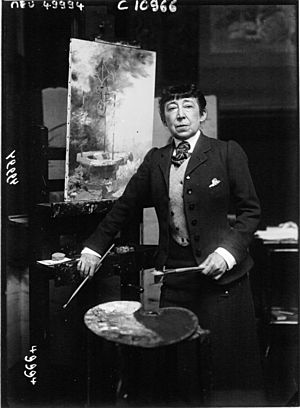Louise Abbéma facts for kids
Quick facts for kids
Louise Abbéma
|
|
|---|---|

Louise Abbéma, (1914)
|
|
| Born | 30 October 1853 Étampes, Essonne, France
|
| Died | 10 July 1927 (aged 73) Paris, France
|
| Nationality | French |
| Known for | Painting, Sculpture |
Louise Abbéma (born October 30, 1853, died July 29, 1927) was a talented French artist. She was a painter, sculptor, and designer during a time in France called the Belle Époque, which means 'Beautiful Era'.
Contents
About Louise Abbéma
Louise Abbéma was born in Étampes, France. She came from a rich family in Paris who knew many artists. Her great-grandmother was a famous actress named Louise Contat. Louise Abbéma started painting when she was a teenager.
Her Artistic Training
She learned from famous artists like Charles Joshua Chaplin, Jean-Jacques Henner, and Carolus-Duran. Louise Abbéma first became known for her art at age 23. This was when she painted a portrait of Sarah Bernhardt, a very famous actress. Sarah Bernhardt was her close friend for life.
Famous Works and Style
Louise Abbéma painted portraits of many other important people of her time. She also created large paintings and murals. These artworks decorated places like the Paris Town Hall and the Paris Opera House. Her art could also be seen in many theaters, including the "Theatre Sarah Bernhardt." She even decorated the "Palace of the Colonial Governor" in Dakar, Senegal.
Her painting style was a mix of academic and impressionistic art. This means she used light and quick brushstrokes in her work.
Exhibitions and Recognition
Louise Abbéma often showed her art at the Paris Salon, a famous art show. She received an honorable mention for her paintings in 1881. Her work was also displayed at the 1893 World's Columbian Exposition in Chicago. This was a big world's fair. A sculpture of Louise Abbéma, made by Sarah Bernhardt, was also shown there.
Louise Abbéma was best known for her oil portraits and watercolors. Many of her paintings showed influences from Chinese and Japanese art. She also admired artists like Édouard Manet. She often included flowers in her artworks. Some of her most famous pieces include The Seasons and April Morning, Place de la Concorde. She also painted portraits of Emperor Dom Pedro II of Brazil and Charles Garnier.
Other Talents and Honors
Besides painting, Louise Abbéma was also good at making prints and sculptures. She was also a designer. She was a writer too, and regularly wrote for art magazines like Gazette des Beaux-Arts. She also drew pictures for several books.
Louise Abbéma received many awards for her work. In 1887, she received the Palme Academiques. She was also named an "Official Painter of the French Third Republic." She won a bronze medal at the 1900 Exposition Universelle, another big world's fair. In 1906, she was given the Chevalier of the Order of the Légion d'honneur. This is a very high award in France.
Louise Abbéma passed away in Paris in 1927. Her art has become popular again in recent years. This is because people are looking more closely at the contributions of women artists throughout history. Her work was part of the 2018 exhibit Women in Paris 1850-1900.
The "New Woman" Idea
In the 1800s, women started to have more chances for education. This led to women artists becoming more professional. They even started their own art groups. At that time, some people thought art made by women was not as good. To fight this idea, women artists became more confident. They worked hard to promote their own art.
This helped create the idea of the "New Woman." This was a modern, educated, and freer woman. Artists like Louise Abbéma played a big part in showing what the New Woman was like. They did this by drawing pictures of this new type of woman. They also lived their own lives in a way that showed this new idea.
For example, Louise Abbéma created self-portraits where she dressed in ways that were not typically feminine or masculine. This helped show that intellectual life was important. Many of her other portraits showed women dressed in similar ways. They were also shown doing activities that were usually done by men. This included intellectual hobbies.
Gallery
See also
 In Spanish: Louise Abbéma para niños
In Spanish: Louise Abbéma para niños











